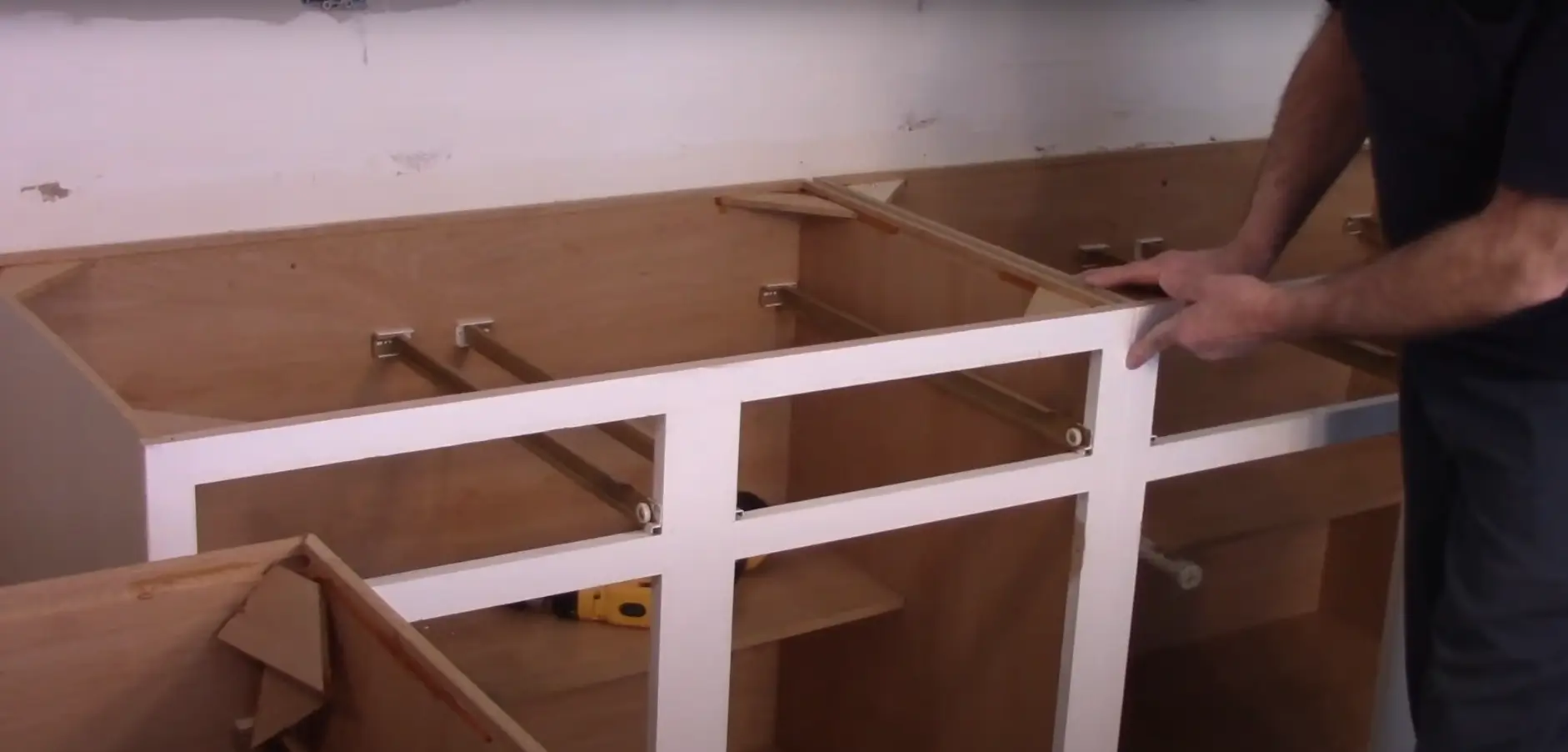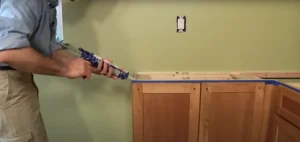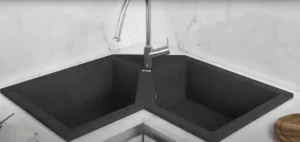Are you tired of your old kitchen cabinets but love your countertops? You might wonder, “Can you replace cabinets without removing countertops?” Good news! It’s possible to update your cabinets while keeping your beloved countertops intact.
This smart move can save you time, money, and hassle during your kitchen makeover.
Many homeowners don’t know that you can swap out cabinets without touching the countertops. This trick works well with sturdy surfaces like granite or quartz. Our guide will walk you through the steps to replace your cabinets safely.
We’ll cover the tools you need, tips to avoid damage, and when to call in the pros. Ready to give your kitchen a fresh look? Let’s get started!
Key Takeaways
- You can replace cabinets without removing countertops, saving time and money during kitchen updates.
- Careful planning and precision are key when removing old cabinets and installing new ones under existing countertops.
- Proper tools like screwdrivers, pry bars, levels, and safety gear are essential for this project.
- Protecting countertops with drop cloths and using shims to support them helps prevent damage during cabinet replacement.
- Hiring professionals is wise for complex jobs, especially with heavy stone countertops or tricky plumbing work.
Is It Possible to Replace Cabinets Without Removing Countertops?
Yes, you can replace cabinets without removing countertops. This process saves time, and money, and protects your existing countertops. Many homeowners choose this option to update their kitchen or bathroom without a full remodel.
The key is careful planning and execution to avoid damaging the countertops during cabinet removal and installation.
Replacing cabinets while keeping countertops in place requires precision and skill. You’ll need to remove old cabinets carefully, then fit new ones under the existing countertop. This method works well with granite or quartz countertops, which are often costly to replace.
Professional help is recommended for this task, especially if you’re not experienced with home improvement projects. Next, let’s look at the steps to replace cabinets without removing countertops.
Steps to Replace Cabinets Without Removing Countertops
Replacing cabinets without removing countertops needs careful planning and skill. The process involves taking out old cabinets and putting in new ones while keeping the countertop intact.
Removing the Old Cabinets Carefully
Removing old cabinets needs care and planning. Here’s how to do it without damaging your countertops:
- Empty all cabinets and drawers. Take out everything to make the job easier.
- Remove cabinet doors and drawers. Unscrew hinges and handles to detach them.
- Check for screws securing cabinets. Look at the back and bottom of the cabinets for hidden screws.
- Loosen screws holding cabinets to walls. Keep supporting the countertops as you do this.
- Place shims under countertops. This helps hold them up when you remove the cabinets.
- Cut through any caulk or sealant. Use a utility knife to break the seal between cabinets and walls.
- Gently pry cabinets away from walls. Use a pry bar, working slowly to avoid damage.
- Support heavy stone or granite countertops. Get help or use temporary supports during removal.
- Disconnect plumbing and electrical connections. Turn off water and power before working on these.
- Remove cabinets one at a time. Start with end pieces and work your way across.
- Clean up debris and inspect the area. Check for any damage to walls or floors before installing new cabinets.
Installing New Cabinets with Precision
After carefully removing the old cabinets, it’s time to install the new ones. Precision is key in this step to ensure a perfect fit and avoid damaging your countertops.
- Measure the space where the new cabinets will go. Double-check these measurements against the size of your new cabinets.
- Use a level to mark a straight line on the wall. This line will guide you in placing the cabinets evenly.
- Start with the corner cabinet if you have one. Place it in position and check if it’s level.
- Secure the first cabinet to the wall using screws and a drill. Make sure to hit the wall studs for a strong hold.
- Continue adding cabinets one by one. Check that each is level and flush with the others.
- Use shims to adjust the height of the cabinets if needed. This helps them sit evenly under the countertop.
- Once all cabinets are in place, secure them to each other using screws.
- Apply construction adhesive to the top of the cabinets. This will help hold the countertop in place.
- Carefully lower the countertop onto the cabinets. Make sure it’s aligned correctly.
- Allow the adhesive to dry fully before using the new cabinets.
- Install doors, drawers, and hardware. Adjust as needed for smooth operation.
- Check all plumbing and electrical connections. Make sure everything works properly.
Tools and Materials Needed for the Process
Replacing cabinets without removing countertops requires specific tools and materials. Here’s a list of items you’ll need for this kitchen update:
- Screwdriver set: You’ll use these to remove old cabinet screws and install new ones.
- Pry bar: This tool helps gently separate cabinets from walls without damaging surfaces.
- Level: Ensure your new cabinets are straight and even.
- Utility knife: Cut through caulk and other sealants around existing cabinets.
- Safety gear: Gloves and goggles protect your hands and eyes during the process.
- Sledgehammer: Use with care to break apart stubborn cabinet parts if needed.
- Installation screws: These secure your new cabinets to the walls and floor.
- Shims: Small wedges help level and align cabinets during installation.
- Construction glue: This adds extra strength when attaching new cabinets.
- Plywood sheets: Use these to create a stable base for your new cabinets.
- Measuring tape: Accurate measurements are key for a proper fit.
- Pencil: Mark spots for screws and cuts on your new cabinets.
- Drill: Make holes for screws and other attachments quickly.
- Saw: Cut cabinet pieces to fit around pipes or other obstacles.
- Caulk gun: Seal gaps between cabinets and walls or countertops.
- Plumbing tools: You may need these to disconnect and reconnect sink fixtures.
Tips to Avoid Damaging Countertops During Cabinet Replacement
Replacing cabinets without harming countertops needs care and skill. Here are some tips to keep your countertops safe during the process:
- Cover countertops with thick drop cloths to shield them from scratches and dents.
- Remove all items from cabinets to prevent accidents and damage.
- Turn off water and power to avoid plumbing or electrical mishaps.
- Use 2×4 studs to support countertops while working on cabinets underneath.
- Work slowly and carefully, especially when removing old cabinets near countertops.
- Apply painter’s tape along the edges where cabinets meet countertops for extra protection.
- Use shims or wedges to keep countertops level during cabinet removal and installation.
- Ask a friend to help hold the countertop steady while you work on the cabinets.
- Check and double-check measurements before cutting or drilling new cabinets.
- Hire pros if you’re not sure about handling the job safely on your own.
Kitchen Cabinet and Countertop Remodel Considerations
Kitchen remodels often focus on cabinets and countertops. These two elements can change the whole look of your space. Think about mixing cabinet colors for a fresh style. Blue lower cabinets with white uppers are popular now.
Gray and white combos also look great. If you want to save money, try cabinet refacing. This option costs about half as much as new cabinets. Refacing fixes up your old cabinet frames and adds new finishes.
It’s quick too – most jobs take just 3-5 days.
Before you start, plan your layout carefully. Make sure new cabinets will fit with your current countertops. This is key if you’re keeping your old counters. Protect granite tops during the work.
They can chip or crack if bumped. Measure everything twice before you buy or install anything new. Good planning helps avoid costly mistakes and ensures a smooth update to your kitchen.
When to Consider Hiring Professionals
Replacing cabinets without removing countertops can be tricky. Experts have the skills to handle heavy, fragile surfaces like granite or quartz. They also know how to work around sinks and appliances.
If you’re not sure about your DIY skills, it’s smart to call in the pros. They can save you time and prevent costly mistakes. Plus, they have the right tools and experience to get the job done fast.
Professional help is a good idea for big kitchen updates. Contractors can offer advice on design and materials. They also know local building codes and permits. CORE Renovations, for example, focuses on quality work and clear communication.
They finish projects on time and within budget. Hiring pros can make your kitchen remodel smoother and less stressful.
Conclusion
Replacing cabinets without removing countertops is a smart way to update your kitchen. This method saves time, and money, and protects your existing surfaces. With careful planning and the right tools, you can give your space a fresh look.
It’s important to take safety precautions and ask for help if needed. Your new cabinets will transform your kitchen while keeping your beloved countertops intact.
FAQs
1. Is it possible to replace kitchen cabinets without removing the countertops?
Yes, you can replace kitchen cabinets without removing countertops. This process requires careful planning and execution. You’ll need to remove the old cabinet boxes while keeping the countertops in place. Then, install new cabinets underneath. This method works well with slab countertops like granite or laminate.
2. What are the benefits of replacing cabinets without removing countertops?
Replacing cabinets without removing countertops saves time and money. You avoid the hassle of countertop removal and reinstallation. It’s a great way to update your kitchen without breaking the bank. This method also lets you keep your existing sinks or appliances in place.
3. How do you secure new cabinets to existing countertops?
To secure new cabinets, first place shims or wedges under the cabinet boxes for proper alignment. Then, apply construction glue to the top of the cabinets. Finally, screw the cabinets into the wall studs. Make sure to check that everything fits snugly against the countertop.
4. Can all types of countertops stay in place during cabinet replacement?
Most slab countertops can remain in place during cabinet replacement. This includes granite, quartz, and laminate. However, tile countertops might be trickier. Always consult a professional to ensure your current countertops are suitable for this process.
5. What should I consider before replacing cabinets without removing countertops?
Before starting, measure carefully to ensure new cabinets will fit under existing countertops. Check if your current countertops are level. Consider the placement of sinks, appliances, and backsplash. It’s also wise to inspect the condition of your countertops before proceeding.
6. Is it better to replace or reface cabinets when keeping countertops?
Both options can work well. Replacing gives you entirely new cabinets but costs more. Refacing allows you to keep the existing cabinet boxes while updating the doors and hardware. It’s often cheaper and faster. Your choice depends on your budget, time frame, and desired outcome.






